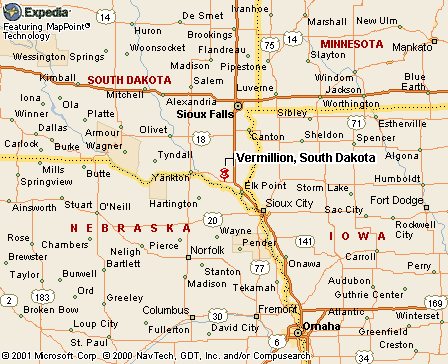|
|
Canku Ota |
|
|
(Many Paths) |
||
|
An Online Newsletter Celebrating Native America |
||
|
July 13, 2002 - Issue 65 |
||
|
|
||
|
Students Paint Traditional Tipis As Part Of Art Institute |
||
|
by Sean Kennedy P&D
Staff Writer
|
||
|
|
 VERMILLION
-- A reception honoring the achievements of 17 student artists at the
12th annual Oscar Howe Native American Summer Art Institute was held Friday
at the Warren M. Lee Center for the Fine Arts on the campus of the University
of South Dakota, Vermillion. VERMILLION
-- A reception honoring the achievements of 17 student artists at the
12th annual Oscar Howe Native American Summer Art Institute was held Friday
at the Warren M. Lee Center for the Fine Arts on the campus of the University
of South Dakota, Vermillion.
Seven full-size tipis painted by the students were on display outside of the building while student art work was on exhibited inside the building. The tipis will be used by the community at the Vermillion Powwow held as part of town's Lewis and Clark Spirit Mound Events Aug. 24. Students at the institute spent around 32 hours, spread across seven days, painting the tipis. Of the 17 students who attended the institute, 15 are in high school and two are in college. "How many average teenagers would have done this? This is just a phenomenal project," said Mary Green Vickery, Lewis and Clark Coordinator for the Vermillion Chamber of Commerce. The tipis were arranged in a traditional manner, according to Melvin Youngbear, who was the technical director for setting up the tipis. He said the tipis were set so that the entrances faced east because the people would rise with the sun. They were also place in a traditional horseshoe shape. Each of the seven tipis represents one of the seven council fires, or each band of the Teton Nation, said Youngbear. The tipis were decorated with traditional symbols and every artist had different reasons for painting each symbol. One tipi, painted by the women at the institute, had paintings of dragonflies, stars and the moon. Colored flags were tied to the ropes and the top of the support poles. According to Youngbear, these flags could represent different families or a person's favorite color. Gerald Cournoyer taught the painting classes at the institute and was also the coordinator of this year's institute. Aside from teaching the students painting, Cournoyer also worked with members of the community and the kids, made sure that illnesses and other medical problems were taken care of, and stayed in contact with tribal elders to make sure that what they were doing was traditionally accurate. Cournoyer said that he typically went to sleep at 2 a.m. and was up again by 6:30 a.m. trying to make sure everything ran smoothly. In attendance at the reception were Heidi Howe, Oscar Howe's wife, and Inge Dawn Maresh, their daughter. This was the first time that Maresh and Howe had visited the institute since it had been reestablished in the 1990s. Maresh said her father would have been proud of how the institute had progressed since he founded it at the university. The institute is helping preserve Native American culture by acquainting young people with it, she said. Maresh attended the institute in the 1960s when her father was teaching. Oscar Howe originally founded the summer program while he was a professor at USD. The program was reestablished in an effort to promote art in the traditional tribal culture. Funding for the tipis came from the Vermillion Area Chamber of Commerce, Wayne Evans, Gene Thin Elk, Women in the Vermillion Native Community and the Vermillion Public School District.
|
|
|
||
|
|
||
| Canku Ota is a free Newsletter celebrating Native America, its traditions and accomplishments . We do not provide subscriber or visitor names to anyone. Some articles presented in Canku Ota may contain copyright material. We have received appropriate permissions for republishing any articles. Material appearing here is distributed without profit or monetary gain to those who have expressed an interest. This is in accordance with Title 17 U.S.C. section 107. | ||
|
Canku Ota is a copyright © 2000, 2001, 2002 of Vicki Lockard and Paul Barry. |
||
 |
 |
|
|
The "Canku Ota - A Newsletter Celebrating Native America" web site and its design is the |
||
|
Copyright © 1999, 2000, 2001, 2002 of Paul C. Barry. |
||
|
All Rights Reserved. |
||
